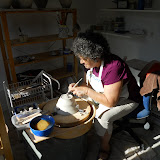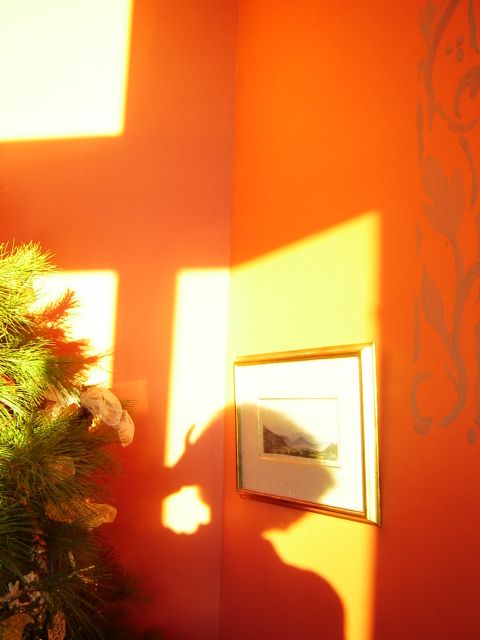THE IDEA OF A MURAL AT LA CUEVA
PETER KING and Hugh Hamilton offered an Architectural Mural workshop in the Summer of 2011 at Hue’s beautiful Art Studio near Kemptville, Ontario.
I felt, -this is for me! That is what I wish to do in our new home in Colombia. When the time came last Summer, however, we were away and did not make it to the Workshop, but after Hanne showed me many photos of the process, told me all about it and together with Bruce and Ricardo, the four of us went to visit our friends Hugh and Susan, see the finished work at the Studio door and talk about it.
This is what I wish to do, again I said to myself as I got home that evening. How could it be? Where, how to do it for our new home?. And started sketching. “We are the people of corn”, remembering Miguel Angel Asturias. And we are the people of guadua, a strong variety of bamboo for construction, used in most of our Latin-American countries in so many creative ways, architectural, traditional, contemporary, structural, artistic and decorative. These are my roots, this is what I must do and express as homage to our culture. The sketches started to take shape of long canes, both bamboo and corn have the same plant structure, monocots, hollow stalks with long pointy leaves. The design became a maquette I made and fired and saw it would work. I showed it to Hanne, and invited her to come to our small town in the Mountains, Villa de Leyva, stay with us and we would both do it. So we did.
Bruce and Hanne came to Colombia for a month, February 2012. After a long and adventurous trip, they arrived at the bus terminal in Villa de Leyva, where we picked them up and went to our home still under construction 5 K North of town.
PREPARATIONS, SETTING UP.
During the previous month, January, Ricardo and I were quite busy: finishing construction of our house and setting up the Art Studio. We brought a truck full of old self dug clay from the 90’s, as it had been sitting in bags at our old cottage where I had my art studio, both rented for the last 10 years while we lived in Canada.
I found the dried up terracotta clay and knew it is a treasure.
It had different types and colors and I start to revive it in water, then select groggy clay and hand wedge some 20 bags, (200 Kg) enough to start our project. We also brought in a small truck my gas kiln, put away for over 10 years. So I had maintenance done by a technician and did a test firing, a failure, it did not work at all. By now, February 4th, Hanne and Bruce have arrived and we start our mural. The first chore is to set up the Art Studio and have the kiln work!. Tables made by mi carpenter sister and her Carlos, organize boards and tools. But we had Ricardo and Bruce’s help. Also by phone, Jorge, the kiln constructor’s advise. (http:/materialesceramicos.com). We made some modifications to the gas installations and we were ready to start. The kiln worked.
DESIGN
First thing to do, from my sketch, was to measure and make the design life size on paper 3m high by 2m wide of two corn stalks at the left and three bamboo branches at the right, joined at the top with a bamboo shut. Birds have been present in my work symbolizing peace, so they are included and I add some small wild animals form the region, a turtle, a hare, a bee, a small alligator, mice and frogs.
I draw tree bamboo shuts at the right, two corn plants with the flower at the end and some corn cobs and rocks as a base. Huge glaciation rocks are found everywhere in the region. At last I felt I am honoring our culture, nature and life in these mountains with the corn, bamboo and some of our native animals and rocks.
MURAL WORK PROCESS
We start making slabs for the canes and leaves. We have a few tools but lack sponges and boards. Could not find any in the small town, had to order plywood to the construction guys for from the city of Tunja. At the Saturday town’s market we find cotton for sheets to cover the work area and boards. We find left over PVC tube cuttings for supports and work really starts. Daily, with Hanne’s discipline, excellent and careful work, my creativity and speed we make a team. I must divide my time between the studio and work in the garden and the construction, but Hanne dedicates all her energy and time to the mural. Slowly canes start to line up, different shape leaves, knots for the joints, animals, rocks. Following the detailed design, two weeks are gone. Now it’s time for drying and to decide between the two of us on how to finish. We get red iron oxide, special tile cement and a tan color grout. Have the entire wall painted raw terracotta color, matching the shade of the house and borrow scaffold from the construction site.
First firing with the text “La Cueva” and tests with the different terracotta clays. It all goes well.
Finishing touches, fitting pieces of bamboo, corn and leaves, finishing edges, measurements and all is set to dry. We take a break, go to the mountains, Hanne and Bruce hike the highest mountain of Iguaque, visit the Goddess at over 4000 m. high in her sacred lake where the founding myths take place. We go back to work, firing the pieces. It all goes well finally with the kiln, after Ricardo and Bruce change the spring of the gas regulator.
Three firings and the mural is ready to be cemented to the wall. Hanne’s fear is the cement, will it work, will it keep the pieces up, will they not fall down during the night?
FINISHING THE MURAL. Set up the scaffold, bring out the numbered pieces in order, apply cement and hold with masking tape till the following day, apply grog, retouch the wall and the day before the two of them travel back to Canada via Bogota, we finish. It’s up, it’s done, it is beautiful. We laugh and hug and toast, it must be up for years to come and many people will see it and join us in this homage to our culture, our roots: corn and bamboo.
 This is our NOW
This is our NOW











.JPG)


.JPG)




.JPG)

.JPG)

.JPG)






.jpg)







.JPG)


